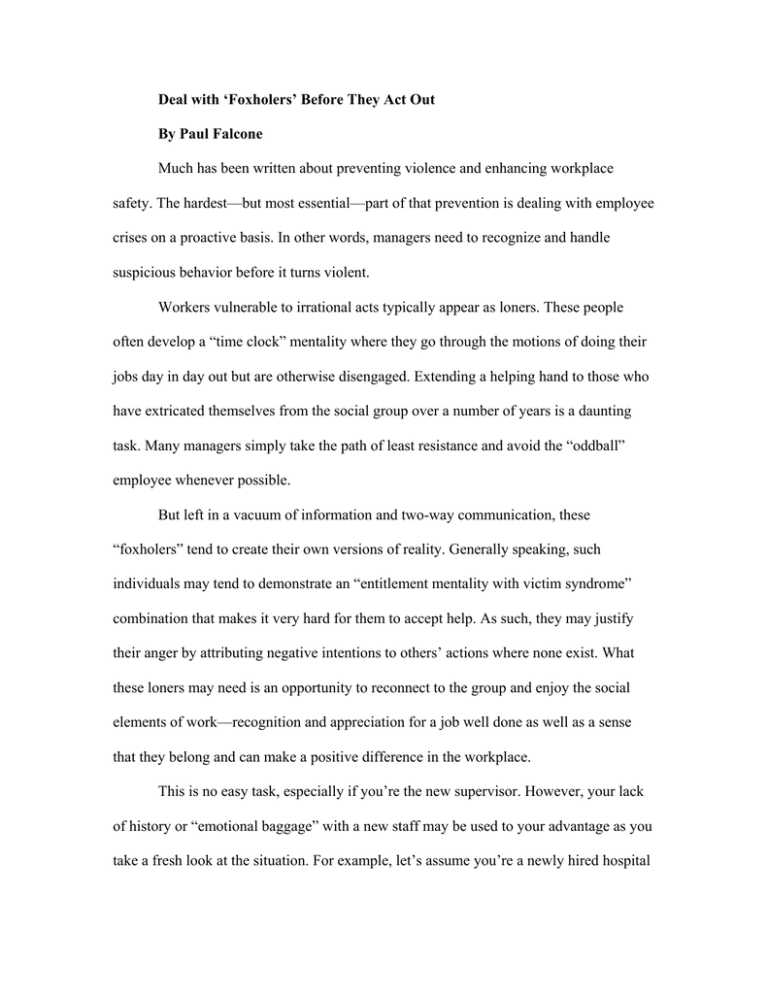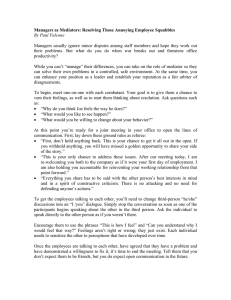Deal with ‘Foxholers’ Before They Act Out By Paul Falcone
advertisement

Deal with ‘Foxholers’ Before They Act Out By Paul Falcone Much has been written about preventing violence and enhancing workplace safety. The hardest—but most essential—part of that prevention is dealing with employee crises on a proactive basis. In other words, managers need to recognize and handle suspicious behavior before it turns violent. Workers vulnerable to irrational acts typically appear as loners. These people often develop a “time clock” mentality where they go through the motions of doing their jobs day in day out but are otherwise disengaged. Extending a helping hand to those who have extricated themselves from the social group over a number of years is a daunting task. Many managers simply take the path of least resistance and avoid the “oddball” employee whenever possible. But left in a vacuum of information and two-way communication, these “foxholers” tend to create their own versions of reality. Generally speaking, such individuals may tend to demonstrate an “entitlement mentality with victim syndrome” combination that makes it very hard for them to accept help. As such, they may justify their anger by attributing negative intentions to others’ actions where none exist. What these loners may need is an opportunity to reconnect to the group and enjoy the social elements of work—recognition and appreciation for a job well done as well as a sense that they belong and can make a positive difference in the workplace. This is no easy task, especially if you’re the new supervisor. However, your lack of history or “emotional baggage” with a new staff may be used to your advantage as you take a fresh look at the situation. For example, let’s assume you’re a newly hired hospital administrator responsible for overseeing a staff of a half dozen nurses in a particular wing of your hospital. Five of the six nurses get along well with each other; they engage in healthy banter, cover for each other when one goes on break and answer other patients’ call lights should the primary nurse be engaged elsewhere on the hospital floor. But one member of the team holds out stubbornly in terms of engaging with the others. You learn that she’s been employed the longest, she used to be known as one of the nicest nurses on staff but has long since given up on trying to make others like her, and she seems to find fault with most people around her. As a result, there is little communication between the two sides, and the environment is at best strained whenever forced interaction occurs. Worse, patient care suffers as patients’ call lights go unanswered whenever this particular nurse is on shift. Your first step will always be to meet with your staff members one-on-one to learn how they view the situation. Ask questions like these: How would you grade our group in terms of camaraderie and teamwork? How do staff members get along with each other, and have you had any particular problems with other members of the group? Are you aware of any particular historical problems among the team members, and could you tell me how they were or weren’t resolved? Did anyone “disengage” after any particular incidents or otherwise appear to be isolated or abandoned from the group? What would you recommend we do to better the situation? After you’ve gathered the information, ask each nurse to support you in your attempt to bring peace to both sides of this rift and to welcome that particular nurse back into the fold. More likely than not, you will hear fairly consistent stories and explanations of the ongoing strife with each employee, and you will probably see both sides of the story objectively and have a better understanding of how the fallout came to be. With each individual’s commitment to do her part in bettering the situation, it will then be time to hold a group meeting. You might open the group meeting like this: “Life is too short. We spend more time with our co-workers than we do with our family members, and there’s certainly more than enough work to go around. What could make this unbearable for all of us, though, is the negative environment that we create because of a lack of communication, harbored unresolved resentments, or a perceived lack of respect in terms of how we’re treating others. You know that I’ve met individually with each of you to learn about this historic rift, and I want you to know that I’m holding each of you accountable for creating a work environment where everyone is treated with respect and dignity. I’m also holding you fully responsible for your own ‘perception management,’ meaning it’s not about right or wrong; it’s about ensuring that others understand your good intentions and are made to feel welcome in our department. “I realize that this situation may have taken years to get to this point, and I’m not naive—it may take just as many years to get to a point where there’s a natural trust and respect in your interactions. But people tend to respond in kind, and if you treat others respectfully, they’ll do the same to you. I’m here to ensure that that’s the case, and I’ll be here for each of you should you need me. Please understand, though, that I won’t stand for missed patient call lights or any attempts at placing blame on others. I also won’t have any members of my staff feeling singled out or otherwise isolated from the rest of the group. In short, if the current situation keeps up, there will be disciplinary consequences. On the other hand, if you support me in making this a more inclusive working environment, then we could all begin to let bygones be bygones and discover new ways of adding value to our hospital’s patient care system. Can I count on your individual and group support?” Allowing people to feel safe about coming out of their foxholes will do more than anything else to avert potential crisis in the workplace. Paul Falcone is director of international human resources at Paramount Pictures in Hollywood, Calif. He is the author of four books published by AMACOM, including The Hiring and Firing Question and Answer Book (2001) and 101 Sample Write-Ups for Documenting Employee Performance Problems: A Guide to Progressive Discipline and Termination (1999). This article represents the views of the author solely as an individual and not in any other capacity. ©2003 Society for Human Resource Management. Members of SHRM are authorized to distribute copies, excerpts or emails of this information for educational purposes internally within their organizations. No other republication or external use is allowed without permission of SHRM. The information is not intended to serve as a substitute for legal advice.







